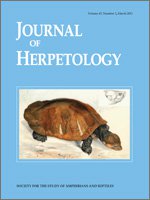Toe clipping is widely used in studies of amphibian ecology and behavior, but its impact on return rates and survival remains controversial. We evaluated the effect of toe clipping on apparent survival, using four comprehensive mark–recapture data sets of four anuran species covering four different time scales and varying life histories. The effect of toe clipping was evaluated by comparing frogs with different numbers of toes removed. Two species, Eleutherodactylus coqui and Hemisus marmoratus, showed minimal effects of toe clipping on apparent survival with seasonal and annual apparent survival decreasing by 0.1% and 1.5% with toe removal, respectively. In Hyperolius nitidulus, daily apparent survival increased on average by 4.1% with toe removal, an effect than can be attributed to disproportionate emigration of the lowest toe-removal group. Finally, in Phrynobatrachus guineensis, individuals with three toes clipped showed an additional 5.0–19.7% decreased apparent survival between weeks when compared to individuals with only one toe clipped. However, the data set was characterized by an interaction between the number of toes clipped and week of marking, thus confounding interpretation. To minimize any effects of toe clipping, we recommend that not more than four toes should be clipped and at most a single toe removed on each leg. In addition, functionally important toes such as the proximal toes of front feet and fourth toes of hind feet should be spared. Furthermore, toe-removal groups should be equally distributed over time to facilitate the analysis of potential toe-clipping effects.
How to translate text using browser tools
1 March 2011
Putting Toe Clipping into Perspective: A Viable Method for Marking Anurans
T. Ulmar Grafe,
Margaret M. Stewart,
Kathrin P. Lampert,
Mark-Oliver Rödel
ACCESS THE FULL ARTICLE

Journal of Herpetology
Vol. 45 • No. 1
March 2011
Vol. 45 • No. 1
March 2011




